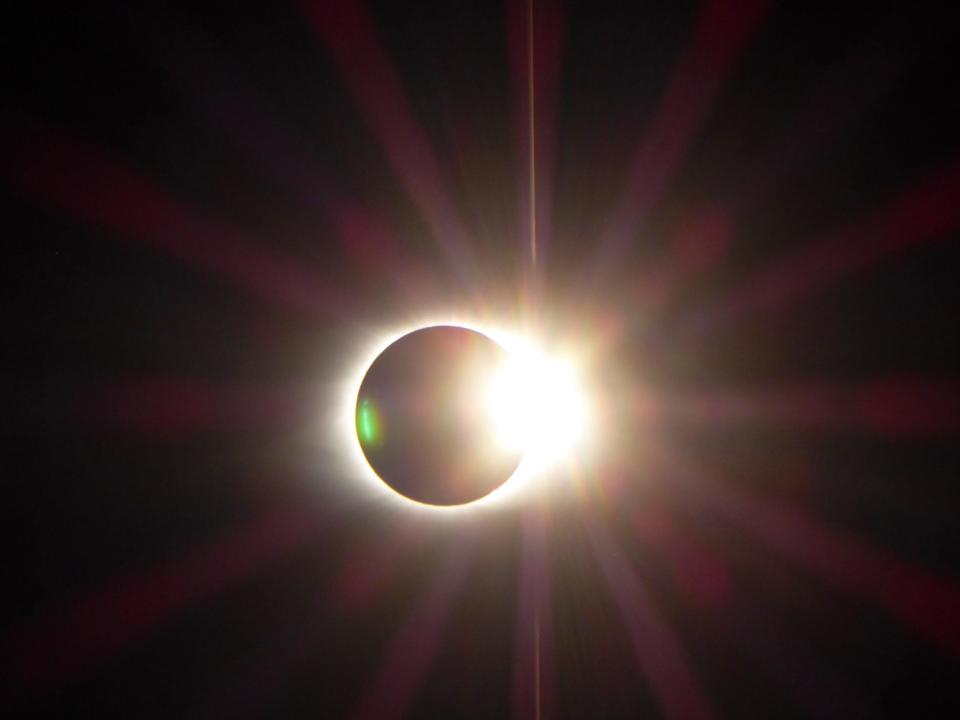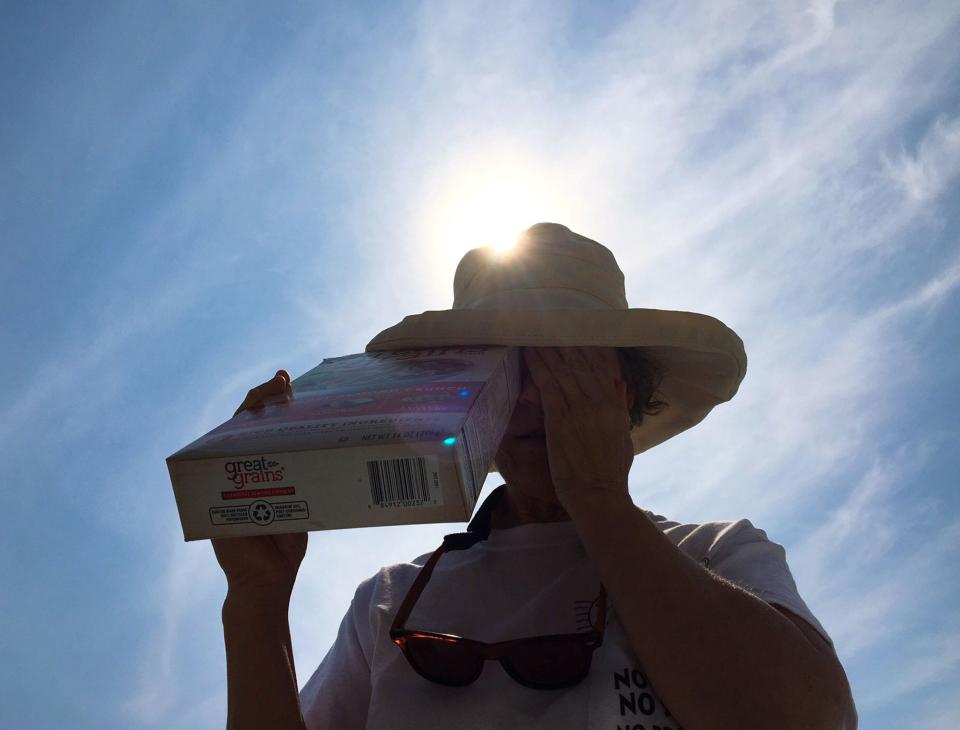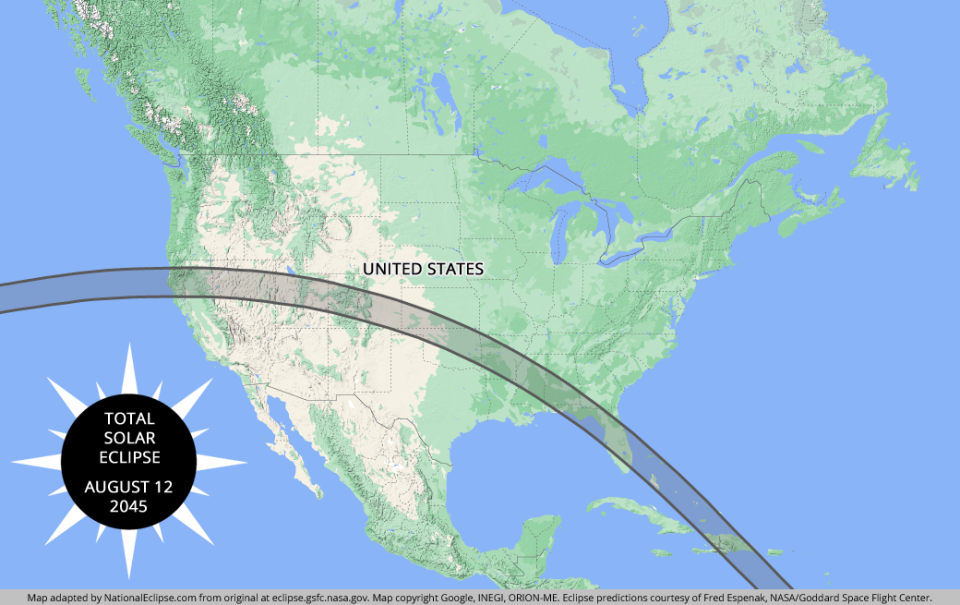The total solar eclipse is today: Get the latest forecast and everything you need to know
Happy Solar Eclipse Day! The first total solar eclipse in the United States since 2017 is happening today, April 8, 2024 and it’s expected to be bigger and better than the one the one that happened seven years ago.
The 115-mile wide path of totality will stretch across 13 U.S. states, with approximately 31 million Americans living in the path of totality. Though, plenty more people are expected to travel to see the spectacle.
Connecticut is just outside the path of totality, with a magnitude of about 92%. That means that CT residents won’t get the full effect, but it will get significantly darker as the vast majority of the sun is blocked by the moon.
Here’s what to know. We’ll be updating this blog throughout the day.
What time is the eclipse in Connecticut?
In Connecticut, the solar eclipse will start at about 2:15 p.m. and peak at about 3:30 p.m., give or take a couple of minutes depending on your exact location in the state. By 4:30 p.m., it will be over and the sun will be shining unobstructed once again.
To narrow it down to your ZIP code, use the embed below:
What is the forecast for the eclipse in Connecticut? Will clouds block the eclipse?
The eclipse forecast has been a major talking point leading up to the event, as no one wants clouds to block their view.
Accuweather is currently predicting mostly sunny skies over Noriwch during the eclipse, with just a few clouds. The National Weather Service is predicting that New England will have some of the best viewing.
See satellite imagery of the could cover at this link.
How much of the sun will be blocked by the solar eclipse?

In Norwich, about 92% of the sun will be blocked by the solar eclipse at its peak.
"While the entirety of New England will experience the solar eclipse on April 8, if you want to see the "totality" of the total solar eclipse, you need to be within the path," Tim Brothers, technical instructor and observatory manager at the MIT Wallace Astrophysical Observatory told Wicked Local in March. "Fortunately, this path covers much of northern and western New England, including New York, although it does not pass over Massachusetts."
For those willing to drive north, parts of Vermont, New Hampshire and Maine will all be in the path of totality. Here's when cities in the path of the eclipse will experience totality.
Burlington, Vermont: 3:26-3:29 p.m. EDT
Lancaster, New Hampshire: 3:27-3:30 p.m. EDT
Caribou, Maine: 3:32-3:34 p.m. EDT
Where can I get solar eclipse glasses?
It’s too late to order glasses, but according to the American Astronomical Society the following retailed are selling eclipse glass, and Warby Parker is even giving them away for free.
Warby Parker (available in stores [for free!] starting April 1st; while supplies last, limit 2 per person)
Alternatively, many public institutions such as libraries are giving away free glasses.
How do I know solar eclipse glasses are safe?
If you buy or are given eclipse glasses, be sure they are made by companies the American Astronomical Society has certified as safe.
NASA does not certify glasses, so be wary of any manufacturers claiming that to have the space agency's approval.
Eclipse glasses should all have the "ISO" (International Organization for Standardization) icon. The glasses also must have the ISO reference number 12312-2.
If you cannot find certified glasses, there are other ways to view the eclipse, including with a shadow box you can make yourself. Whatever you do, don't look at the sun without proper protection.
How to make solar eclipse glasses?

Didn't get your hands on a pair of glasses and don't have time to run to the store? Don't worry! You can still make something at home.
NASA recommends creating a cereal box viewer, using cereal box, cardboard, foil, paper, scissors and tape or glue. Here are the steps:
Steps to make the cereal box eclipse viewer:
Get an empty, clean cereal box.
Cut a white piece of cardboard that will fit snuggly in the bottom of the box, or secure it permanently by gluing it in place.
Cut the top of the cereal box, removing both ends and leaving the center intact.
Put a piece of tape across the center of the top to securely hold it closed.
Tape a piece of heavy-duty foil or double a single layer for additional strength, covering one of the openings at the top of the cereal box. The other opening will remain open for viewing.
Using a small nail (approximately 3mm in diameter) push a hole in the foil.
Cover the entire box with construction paper, leaving the single-viewing opening and the foil uncovered.
Once it is done, to use it you point the pinhole at the sun and then with your back facing the sun, look through the viewing opening. A small image of the sun should be reflected on the white paper in the box.
More ways to make eclipse glasses: Forgot to get solar eclipse glasses? Here's how to DIY a viewer with household items.
Can you drive during a solar eclipse?
It's safe to drive during an eclipse as long as you don't look up at the sky. AAA is telling drivers to be focused on the road during the total solar eclipse.
The automobile insurance company is advising Americans who want to safely view the eclipse to find a safe place to park and wear your eclipse glasses.
Authorities also are reminding people to not drive while wearing solar eclipse glasses. Eclipse glasses are designed specifically for an eclipse, and you would not be able to see the road well enough while wearing them.
What is a solar eclipse?
A total solar eclipse happens when three celestial spheres — the sun, moon and Earth — line up in a specific way in space.
According to NASA, a solar eclipse happens when the moon's orbit aligns with Earth, and it passes between the sun and Earth. That casts a moving shadow on Earth that either fully or partially blocks the sun's light in some areas. This leads to a period of partial or full darkness on a narrow stretch of Earth.
A solar eclipse happens during a new moon, EarthSky said. A lunar eclipse, however, happens during a full moon, when the Earth, sun and moon align in space.
When is the next solar eclipse?
For North America, the next total solar eclipse won't be until Aug. 23, 2044, according to NASA.
Unfortunately, the 2044 total solar eclipse won't have the broad reach across the U.S. as the 2024 eclipse, and it won't be coming anywhere near New England. That eclipse will be visible in Greenland, sweep through Canada and end around sunset in Montana, North Dakota and South Dakota. Make your travel plans accordingly.
There's another solar eclipse in 2045 that will cut through a larger swath of the U.S., but once again won't come through New England. That eclipse, expected to occur on Saturday, Aug. 12, 2045, will trace a path of totality over California, Nevada, Utah, Colorado, New Mexico, Oklahoma, Kansas, Texas, Arkansas, Missouri, Mississippi, Louisiana, Alabama, Florida, and Georgia.

How fast does an eclipse shadow travel?
According to a post from the National Weather Service in Indianapolis on X, an eclipse shadow travels at speeds from 1,100 to 5,000 mph. Near the equator, it travels at around 1,100 mph and increases in speed as it approaches the poles.
What is the effect of the eclipse on pets?
When it comes to pets and today's eclipse, experts say it's better to leave your pets home, rather than have them travel and observe the phenomenon.
Experts' biggest concern is not what’s happening in the sky but on the ground as crowds of excited and anxious people gather, said Dr. Rena Carlson, president of the American Veterinary Medical Association told USA Today.
:
“Rather than the effects of the eclipse, I would be more worried about the excitement and all of the people,” she said.
In a recent statement to Wicked Local, regarding sheer volume of people going to witness the eclipse, AAA stated, "AAA car rental partner Hertz reports a 3,000% increase over last year in advance bookings for eclipse path cities."
USA Today said Dr. Jerry Klein, chief veterinarian of the American Kennel Club, noted "dogs that are sensitive, that have anxiety or are strongly affected by storms are likely to pick up on the emotions of people gathering to watch the eclipse."
Klein added that if you are taking a pet to the eclipse, make sure you are watching them closely.
“Make sure they have plenty of fresh water, that they’re not overly crowded, that they’re kept on a leash and that they have a way to be recognized if they bolt off and get lost,” he told USA Today.
Veteranarians have said that cats are not typically affected by eclipses.
Places to watch the eclipse
If you're interested in checking out the eclipse with other people, here are a few options.
Come and learn all about the solar eclipse and participate in activities with CT State Parks, CT State Library, UConn Extension, Goodwin-Niering Center for the Environment and Camp Harkness staff and volunteers. This event will take place from 1 to 4:45 p.m. on April 8.
To allow access to both parks and the beach, the program will take place at Camp Harkness, Harkness Memorial State Park and Waterford Beach.
Parking will be at Camp Harkness, 301 Great Neck Road in Waterford. Participants should look for signs directing them to the event.
The Connecticut Science Center in Hartford will host eclipse activities throughout the day on April 8. There will be a live viewing, as well as interactive exhibits and activities. There will also be a livestream of the total solar eclipse in the theater at the science center.
A viewing party for the partial solar eclipse will take place at Yale University’s Leitner Family Observatory and Planetarium. A limited supply of eclipse glasses will be given out at the event, so guests should bring their own just in case.
Will regional airports be affected by the eclipse?
If you happen to be traveling by airplane today, things could get hectic because of the eclipse, depending where you are.
The good news is that the main airports in Connecticut and Rhode Island will not be affected much.
Of today's solar eclipse, the Federal Aviation Administration (FAA) stated that "aircraft should be prepared for potential airborne holding, reroutes, and/or Expect Departure Clearance Times (EDCTs) that may be issued for all domestic…arrivals and departures.
"There may be a higher traffic volume than normal anticipated at airports along the path of the eclipse. Traffic should anticipate delays during peak traffic periods. Parking may be limited – particularly at the smaller, uncontrolled airports. There could be a delay with issuance of… departure clearances.
"Practice approaches, touch-and-goes, flight following services and pilot training operations at airports in the path of the eclipse may be extremely limited and possibly prohibited during this time period."
The FAA noted that neither Logan Airport in Boston, or T.F. Green in Rhode Island, are listed as airports being affected by today's eclipse.
How to livestream today's eclipse
To watch today's astrological event, you can log onto USA Today's livestream of the solar eclipse here.
"Expect the eclipse to start shortly after 2 p.m. The totality will start after 3 p.m. and the eclipse itself will conclude after 4:30 p.m." Tim Brothers, technical instructor and observatory manager at the MIT Wallace Astrophysical Observatory in Westford, told Wicked Local in a past interview.
According to USA Today, "The total eclipse will begin in Mexico at about 11:07 a.m. PDT, Monday before crossing into Texas at 1:27 p.m. CDT. It will end in Maine at 3:35 p.m. EDT. The partial eclipse will last for awhile longer. Even if you're not in the path of totality and won't see the full eclipse, you may still see a percentage of it."
Some tips for taking photos of today's eclipse
According to Space.com, there are a few tricks to taking photos of today's eclipse with your smartphone:
Disable your flash, especially if you are in the path of totality - according to Space.com, "Using flash won't help your photography and, worse, it will detract from the experience of totality for everyone around you."
Avoid zooming in on the eclipse. Space.com, notes, "As the eclipsed sun appears, the temptation is to pinch the screen to zoom in as far as you can. It's so tempting, particularly if your smartphone has a so-called 'superzoom', but it rarely heralds good results."
Use "super-wide" or "portrait" settings on your phone when taking photos of the eclipse.
Use "focus-lock" when taking photos of the eclipse. Space.com states, "Exactly how you do that will depend on what smartphone you have and what app you use. For example, on an iPhone's native camera app, you touch what you want to focus on by pressing on the object on your smartphone's screen for a second or so. This will lock the focus so you can concentrate only on composition."
Enable "burst mode" while taking photos, so you can take several pictures very quickly.
If you decide to shoot video, use a tripod to avoid any shaking that could possibly occur via hand-held recording.
These tips are all courtesy of Space.com.
How does the weather look for the rest of April 8?
According to the National Weather Service in Norton, "High pressure brings dry conditions and mostly sunny skies today."
This blog will be updated throughout the day. Keep checking back for more. USA Today reporters have contributed to this report.
This article originally appeared on The Providence Journal: Total Solar Eclipse 2024 in Connecticut: What time, forecast, more

